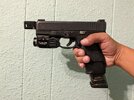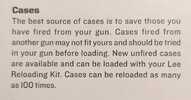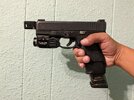The info is somewhere. Probably not on the interwebs links but in reloading manuals and manufacturers' reloading equipment manuals. I'm not the one who makes sizing dies, there are a couple companies that do that and they all make the sizing dies just shy of what the typical barrel chambers allow the expansion of cases to be. Obviously, to reduce excessive sizing of the case mostly for safety. Im not the one who has issues with setback because I use a larger bullet to have proper neck tension when reloading. I'm not the one who created a different set of dies that will allow reloaders to size their cases to factory spec, or near it, if they so choose and named said dies Factory Crimp Die or Undersizing Die obviously to imply that those dies are not your regular set of sizing dies originally intended for reloading, probably to further imply a disclaimer in case they get sued by someone who got hurt in a kaboom because they prematurely overstressed their casing. I'm not the one who created the physics of the world and made it so that when you stretch or bend metal in opposite directions over and over again it is supposed to break apart. Because, you know, thats exactly what happens yo casings through usage. Firing them causes expansion and the hotter the round the higher the stress, sizing them causes contraction and the smaller you size the higher the stress. Eventually, with signs or without, the case can crack, rupture, or burst during the firing process.
There might not be a wrong or right way to reload, but there is definitely a way to prevent unnecessary stress by reducing steps. Flaring and crimping creates stress at the case mouth. Both steps can be avoided by chamfering(only once) and using a correct bullet size (trial and error) that can be seated and held by the neck tension. Beveled base bullets also help to make seating easier.
I understand there can be some loads that inevitably require the extra steps. Also, the reloader only knows that process and it has worked for them. Also, safety checks can be made, and should be either way, which will prevent kabooms anyways. Its a choice, but its not hard to see that there is a safer choice which also requires less steps in the reloading process. I mean, why crimp if it's not needed? It only requires purchasing a new set of bullets. If I want to make hot loads, the cases should last much longer without crimping or undersizing. Thats not to say that those tools should not be owned. I dont have any but I, like the OP, I plan to include those in my kit eventually for those inevitable loads.
I have not purchased any .451 bullets myself as of yet. It can be that they will hold tension fine without requiring the extra steps, for now I know better than to risk it because I do not want to spend the bucks on new supplies just yet. Maybe in a couple weeks, or a couple months, or years. I dont know. There are still several. 452 bullets I want to try and a couple more powders as well as I want to first get a set of steel targets and a new gun. I understand that it’s best to reload the way you know before experimenting with a new method. All I know is that I dont have setback issues, Im getting small spreads, good accuracy, and reliable feeding. The plunk test is excellent as well. I only collect my personally fired 45acp brass using a KKM barrel. I know that yesterday I accidentally allowed some cases fired from my Glock barrel to get mixed in the fired brass bin. I'm curious to know how different it will be reloading with those cases.
View attachment 1174894View attachment 1174896




